Review: Minnesota Orchestra and new composers make beautiful music - sometimes
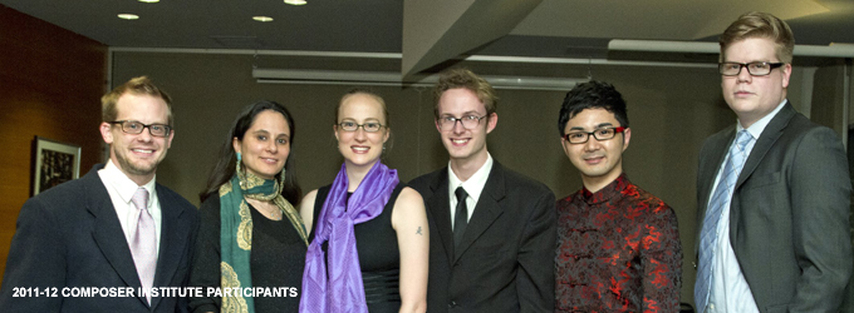
TwinCities•com
PIONEER PRESS
By Rob Hubbard
Special to the Pioneer Press
Posted: 01/06/2012 12:01:00 AM CST
Updated: 02/09/2012 10:09:23 AM CST
Ripped cabbages, macaroni-and-cheese and talking dolls as percussion instruments. Undulating waves of sound and dreamy mystical landscapes. Music that evokes a swarm of insects or a gastrointestinal process.
These were among the challenges presented to conductor Osmo Vanska and the Minnesota Orchestra by the pieces rehearsed at this week's 11th annual Composer Institute. Six composers worked with the orchestra all week, concluding with Friday night's performance of their pieces. It's a concert that helps audiences get a finger on the pulse of contemporary composition's direction, and perhaps discover an exciting new voice on the way up.
So who among Friday's six composers seemed most likely to succeed? Well, all had much to recommend them, but the most memorable work among those performed was the finale, Brian Ciach's "Collective Uncommon: Seven Orchestral Studies on Medical Oddities." Ciach was the composer most intent upon letting his imagination run wild all over the music (hence the cabbages and dolls), but he also had the strongest sense of how to create layers of sounds, rather than the clusters that some of the others favored.
One complaint I've sometimes had after past Composer Institute concerts is that the composers didn't use enough of the orchestral resources available to them. But that feeling was shunted aside immediately by Michael R. Holloway's "Rhythm: Theta Beta Theta." The only composer among the group with Twin Cities ties (he's a recent graduate of St. Paul's McNally Smith College of Music), Holloway has a way with creating an atmosphere, building tension to a violent eruption that featured chaotic clashes of harmony and rhythm.
Surely, we're going to hear more from Shen Yiwen, who is having works premiered this year by orchestras in both China and the U.S. And Sweden's Adrian Knight demonstrated his gift for creating an atmosphere on the sedate and dream-like "Manchester."
But that piece also served a reminder that many new compositions sound as if they're auditions for film work, which is understandable when one considers that that might be an aspiring composer's quickest route to a steady paycheck. The evocative soundscapes of Portugal's Andreia Pinto-Correia certainly have a future there, as may the conflict-fueled sound clusters of Hannah Lash.
Yet "clusters" is a key word here. Many of the works piled big sound upon big sound, creating a bludgeoning effect that left me wishing for more intricate layering. Seldom did the composers allow a soloist to soar above the sound. It often felt Friday as if they wanted to seize this opportunity of working with a first-rate symphony orchestra by pulling out all the stops. With more experience, they'll likely learn to use more of the colors an orchestra offers.
Rob Hubbard can be reached at rhubbard@pioneerpress.com.
Symphonic Premiere
(From "Three Joyous Concerts", Bloomington Herald Times)
By Peter Jacobi
Herald-Times Reviewer | pjacobi@heraldt.com
10/12/2011
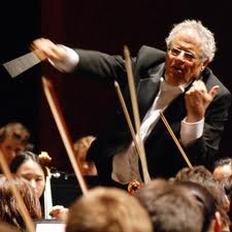
On Sunday evening in the Musical Arts Center, conductor David Effron and the IU Concert Orchestra gave a debut performance of “Collective Uncommon,” winner of the 2011 Dean’s Prize.
Reading composer Brian Ciach’s notes ahead of the hearing, one might have wondered and worried. The 16-minute work is subtitled “Seven Orchestral Studies on Medical Oddities” and was inspired, Ciach says, by exhibits in Philadelphia’s Muller Museum of the College of Physicians, including “The Progressive Ossification of Harry Eastlack,” “The Human Horn Growing on the Forehead of Madame Dimanche,” “The Screaming Soap Lady” and “Dance of the Siamese Twins: Chang and Eng Bunker.”
The program notes were enough to spook one out. Fortunately, Jacobs School alum Ciach’s music turned out to be far more acceptable. In fact, one could read all sorts of interpretations into what one actually heard. But just listening brought moments of sheer excitement from how imaginatively the composer used his skills in orchestration to suggest chaos and furor, mystery and alarm, sympathy and wonder. The score contains much to admire and deserves further hearing. Effron and the Concert Orchestra gave the piece a rousing sendoff.
Rousing, indeed, was an appropriate descriptive adjective for the rest of the program, its content and handling: first of that delightful Viennese bon bon, Franz von Suppe’s Overture to “Poet and Peasant,” and, finally, the Bela Bartok masterpiece, Concerto for Orchestra, in which a symphonic ensemble can show off its collective skill as would a soloist in the normal concerto. Maestro Effron made sure the Concert Orchestra did exactly that.
Reading composer Brian Ciach’s notes ahead of the hearing, one might have wondered and worried. The 16-minute work is subtitled “Seven Orchestral Studies on Medical Oddities” and was inspired, Ciach says, by exhibits in Philadelphia’s Muller Museum of the College of Physicians, including “The Progressive Ossification of Harry Eastlack,” “The Human Horn Growing on the Forehead of Madame Dimanche,” “The Screaming Soap Lady” and “Dance of the Siamese Twins: Chang and Eng Bunker.”
The program notes were enough to spook one out. Fortunately, Jacobs School alum Ciach’s music turned out to be far more acceptable. In fact, one could read all sorts of interpretations into what one actually heard. But just listening brought moments of sheer excitement from how imaginatively the composer used his skills in orchestration to suggest chaos and furor, mystery and alarm, sympathy and wonder. The score contains much to admire and deserves further hearing. Effron and the Concert Orchestra gave the piece a rousing sendoff.
Rousing, indeed, was an appropriate descriptive adjective for the rest of the program, its content and handling: first of that delightful Viennese bon bon, Franz von Suppe’s Overture to “Poet and Peasant,” and, finally, the Bela Bartok masterpiece, Concerto for Orchestra, in which a symphonic ensemble can show off its collective skill as would a soloist in the normal concerto. Maestro Effron made sure the Concert Orchestra did exactly that.
Jacobs student wins world competition
By BIZ CARSON | Indiana Daily Student
POSTED AT 11:19 PM ON SEP. 9, 2010
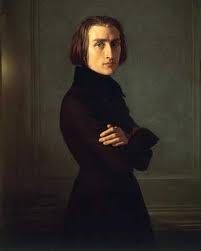
One minute and 17 seconds into the second movement, Brian Ciach hit the piano too hard.
A screw fell out, hitting the inside of the piano with a loud ping and causing a cloud of dust to blow straight into his face.
Ciach was shocked, but he had just experienced his first “Lisztian” moment.
Three years later, Ciach had his second when that piece, “Piano Sonata 2” tied for first place in the American Liszt Society’s Bicentennial Composition Competition this July.
Ciach and his fellow winner, Gilad Cohen of Princeton University, are splitting the $4,000 prize provided by Steinway and Sons.
The American Liszt Society is named after Franz Liszt, the famous Hungarian composer and piano virtuoso known for his dramatic flair.
“I feel like I’m inspired by his spirit,” said Ciach, a doctoral candidate in the composition department at the Jacobs School of Music. “I like to, in a sense, put on a show. But it’s all in the service of the sound of the music.”
However, in the American Liszt Society’s competition, Ciach couldn’t rely on loose screws to create drama and excitement in his music.
Composers from 11 countries submitted 32 previously unpublished pieces to the composition, explained Richard Zimdars, artistic director of the American Liszt Society’s bicentennial festival and music professor at the University of Georgia.
Zimdars said he was happy that pieces were stylistically all over the map, as they weren’t looking for imitations of Liszt’s works.
“I looked at the pieces, and the styles ranged from very conservative to really far and good avant-garde,” he said.
Ciach places his piece in the middle, but he does so with the typical Liszt virtuoso flair.
“It’s definitely not standard or entirely avant-garde,” he said. “I added some percussive effects where you’re knocking on the key board or slapping your hands. It’s a physically demanding piece.”
The full use of the instrument and the resulting music from it are what competition judge Paul Barnes liked about Ciach’s piece.
“He had a very effective use of the piano that was innovative,” said Barnes, a Jacobs School of Music alumnus and music professor at the University of Nebraska. “It was also incredibly expressive... it is something that makes you look inward.”
It was the internal desire to play piano that made Ciach write the sonata.
Ciach’s sonata will be played this February for an international crowd at the American Liszt Society’s Bicentennial Festival at the University of Georgia.
“My inspiration was just the internal need to play music,” Ciach said. “When I got the e-mail that I won, I was surprised and beguiled. I wrote it essentially for myself.”
A screw fell out, hitting the inside of the piano with a loud ping and causing a cloud of dust to blow straight into his face.
Ciach was shocked, but he had just experienced his first “Lisztian” moment.
Three years later, Ciach had his second when that piece, “Piano Sonata 2” tied for first place in the American Liszt Society’s Bicentennial Composition Competition this July.
Ciach and his fellow winner, Gilad Cohen of Princeton University, are splitting the $4,000 prize provided by Steinway and Sons.
The American Liszt Society is named after Franz Liszt, the famous Hungarian composer and piano virtuoso known for his dramatic flair.
“I feel like I’m inspired by his spirit,” said Ciach, a doctoral candidate in the composition department at the Jacobs School of Music. “I like to, in a sense, put on a show. But it’s all in the service of the sound of the music.”
However, in the American Liszt Society’s competition, Ciach couldn’t rely on loose screws to create drama and excitement in his music.
Composers from 11 countries submitted 32 previously unpublished pieces to the composition, explained Richard Zimdars, artistic director of the American Liszt Society’s bicentennial festival and music professor at the University of Georgia.
Zimdars said he was happy that pieces were stylistically all over the map, as they weren’t looking for imitations of Liszt’s works.
“I looked at the pieces, and the styles ranged from very conservative to really far and good avant-garde,” he said.
Ciach places his piece in the middle, but he does so with the typical Liszt virtuoso flair.
“It’s definitely not standard or entirely avant-garde,” he said. “I added some percussive effects where you’re knocking on the key board or slapping your hands. It’s a physically demanding piece.”
The full use of the instrument and the resulting music from it are what competition judge Paul Barnes liked about Ciach’s piece.
“He had a very effective use of the piano that was innovative,” said Barnes, a Jacobs School of Music alumnus and music professor at the University of Nebraska. “It was also incredibly expressive... it is something that makes you look inward.”
It was the internal desire to play piano that made Ciach write the sonata.
Ciach’s sonata will be played this February for an international crowd at the American Liszt Society’s Bicentennial Festival at the University of Georgia.
“My inspiration was just the internal need to play music,” Ciach said. “When I got the e-mail that I won, I was surprised and beguiled. I wrote it essentially for myself.”
IU Jacobs School of Music student co-winner of international competition
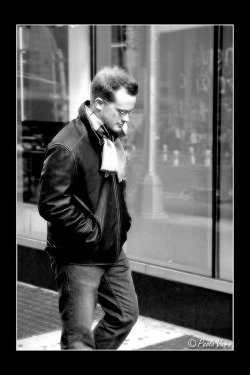
IU News Room
Sept. 3, 2010
BLOOMINGTON, Ind. -- Brian Ciach, a doctoral candidate in the Composition Department at the Indiana University Jacobs School of Music, is a co-winner of the American Liszt Society (ALS) Bicentennial Composition Competition. He will share the $4,000 prize donated by Steinway & Sons with Gilad Cohen, a doctoral student in composition at Princeton University.
Thirty-two compositions were accepted from composers from Australia, Thailand, Israel, England, Sweden, Russia, Germany, Switzerland, France, Austria and the United States.
Ciach's winning piece, Second Piano Sonata, will receive its world premiere at the 2011 ALS Bicentennial Festival at the Hugh Hodgson School of Music, University of Georgia, on Feb. 19, 2011. It will be performed by Paul Barnes, professor of piano at the University of Nebraska and a graduate of the Jacobs School of Music.
"I am honored and thrilled that my Second Piano Sonata was selected for the first prize award and a performance by pianist Paul Barnes in the American Liszt Society's 2011 national festival," said Ciach.
"The Second Sonata is extremely virtuosic in true Lisztian style. The rapid toccata movement involves knocking of the end blocks and slapping of the piano arms at climactic points. The intense, quick repeated notes run off of the keyboard, turning into knocking on the wooden frame. It's something I've always wanted to do with a piano work -- essentially 'run out of notes.'"
When he first performed the piece, Ciach said, this aggressive style caused the piano to shake so much that a screw actually fell out of the raised piano lid. The screw fell onto the iron frame, making a loud "ping" along with wood dust flying into his face. "I'm no Franz Liszt, but these types of theatrics -- though unintentional in my case -- are not averse to the spirit of the old master."
Ciach is in his final year in the Doctor of Music in Composition program at Jacobs. He has studied with Claude Baker, Don Freund, John Gibson, Jeffrey Hass, P.Q. Phan and Sven-David Sandström. He has two master's degrees in composition and piano performance and an undergraduate degree in piano performance from Temple University, where he studied piano with Charles Abramovic and Lambert Orkis. His composition teachers at Temple were Richard Brodhead, Matthew Greenbaum and Maurice Wright. Ciach has also studied privately with Richard Wernick.
The 2011 ALS Festival will be North America's largest celebration of the bicentennial of Liszt's birth. ALS President Thomas Mastroianni is a Jacobs School alumnus.
The evening before Ciach's piece is performed, William Bolcom's Laura Sonnets also will receive its world premiere at the festival.
For more information about the Jacobs School of Music, visit http://music.indiana.edu.
Copyright © 2010 The Trustees of Indiana University | Copyright Complaints
Music review: Percussion Ensemble
Musicians jump from instrument to instrument in well-executed program
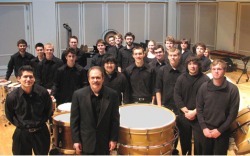
By Peter Jacobi
Bloomington Herald Times Reviewer
November 13, 2009
Brian Ciach, a doctoral student in composition at the Jacobs School, had an opportunity on Monday evening to hear one of his own creations, a premiere performance by the IU Percussion Ensemble of “Strange Assortments,” a remarkably inventive piece commissioned by Kevin Bobo, the ensemble’s co-director.
The three-movement work was a highlight among highlights in an extremely well-executed program given in Auer Hall that featured Percussion Ensemble members in small clusters rather than whole unit fashion. That gave the listener/viewer an opportunity to focus on individual talents, to watch them move assuredly and dexterously from instrument to instrument, seeming to be masters of all. They exhibited some remarkable skills.
Ciach’s handiwork was designed to shape images. For instance, according to the composer, the opening movement, “Newton’s Cradle,” “depicts a desktop toy pendulum with its constant energy, driving pulse, and often quiet intensity.” Well, one has to take his word about the pendulum, but the remainder of his explanation is right on. The music is energetic and driving, with moments of “quiet intensity,” and it was played ever so intensely by multi-taskers Tim Crockett, Lauren Donnelly, Josh Frans, Parker Lee, Brian Mueller and J.J. Pearse.
They didn’t let down during the inventive movements that followed: a mysterious, other worldly “Singing Spheres” (with tam tams sinking into and rising from tubs of water and with all sorts of ringing instruments, bells and glockenspiel among them), and a movement of instrumental surprises and lease-breaking volume representing the Mummer’s Parade in Ciach’s hometown, Philadelphia.
Copyright: HeraldTimesOnline.com 2009
Bloomington Herald Times Reviewer
November 13, 2009
Brian Ciach, a doctoral student in composition at the Jacobs School, had an opportunity on Monday evening to hear one of his own creations, a premiere performance by the IU Percussion Ensemble of “Strange Assortments,” a remarkably inventive piece commissioned by Kevin Bobo, the ensemble’s co-director.
The three-movement work was a highlight among highlights in an extremely well-executed program given in Auer Hall that featured Percussion Ensemble members in small clusters rather than whole unit fashion. That gave the listener/viewer an opportunity to focus on individual talents, to watch them move assuredly and dexterously from instrument to instrument, seeming to be masters of all. They exhibited some remarkable skills.
Ciach’s handiwork was designed to shape images. For instance, according to the composer, the opening movement, “Newton’s Cradle,” “depicts a desktop toy pendulum with its constant energy, driving pulse, and often quiet intensity.” Well, one has to take his word about the pendulum, but the remainder of his explanation is right on. The music is energetic and driving, with moments of “quiet intensity,” and it was played ever so intensely by multi-taskers Tim Crockett, Lauren Donnelly, Josh Frans, Parker Lee, Brian Mueller and J.J. Pearse.
They didn’t let down during the inventive movements that followed: a mysterious, other worldly “Singing Spheres” (with tam tams sinking into and rising from tubs of water and with all sorts of ringing instruments, bells and glockenspiel among them), and a movement of instrumental surprises and lease-breaking volume representing the Mummer’s Parade in Ciach’s hometown, Philadelphia.
Copyright: HeraldTimesOnline.com 2009
Seen & Heard International Concert Review
Master’s Recital and Veteran Quartet’s Concert: Brian Ciach and the Juilliard Quartet perform Wernick (April 19, 2004) (BJ)
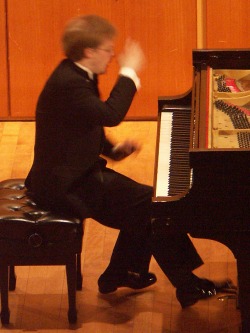
It cannot often happen that the recital given by a student in pursuit of his master’s degree provokes a seasoned critic to write a review for international dissemination. But at Boyer College of Music in Philadelphia’s Temple University on April 19, I witnessed a performance that demanded recognition on that level. The graduand was a young man named Brian Ciach (pronounced, I’m told, "Sigh-ack"), and I assure you that it is a name you will be hearing much of in the not too distant future.
A Philadelphia resident, Ciach studies piano with Charles Abramovic in the excellent keyboard department headed by Harvey Wedeen, and he also studies composition. Something of his artistic seriousness was apparent, even before he had played a note, from the extraordinarily taxing program he had selected for the occasion: Schoenberg’s Suite, Op. 25, Bach’s Partita No. 6 in G Major, and Wernick’s First Piano Sonata. But it was the standard of the actual playing that at first surprised and then, with unfailing certainty of touch and of interpretation, beguiled his audience. The Schoenberg, to start with, was made to sound like real music, which is not always the case when this knotty, sometimes arid, yet curiously charming creation is realized in performance. The Bach partita drew a reading that combined stylistic acumen with beautifully graded tone-colors and tigerish rhythmic attack.
These qualities came even more emphatically into play in the Wernick sonata. Born in Boston in 1934, Richard Wernick retired a few years ago from a professorship of composition at the University of Pennsylvania. He is a much-honored composer–a Pulitzer Prize-winner, and the only man to have won the Friedheim Awards of Washington’s Kennedy Center twice–and his music amply shows why. His First Piano Sonata, completed in 1982 and subtitled Reflections of a Dark Light, is, at something like 40 minutes, his longest work. It is also a work that offers rich rewards to the listener in its poetic richness and majestically controlled formal structure. Laid out at times on four staves, the music makes formidable demands on the performer, but these demands are at least as much in the realm of extremely soft dynamics and sudden expressive contrast as in that of mere technical wizardry. The composer, who was present and who received a warm ovation at the end of the performance, was astonished to see Ciach come on stage to play his piece without any sign of a score in evidence–"Surely he’s not going to play it from memory!", he exclaimed. That, however, is exactly what Ciach did–triumphantly, for though I have heard the sonata played superbly both by Lambert Orkis (another Temple faculty member), for whom it and Wernick’s recent Second Sonata were written, and by the Australian-born Geoffrey Douglas Madge, I found Ciach’s realization fully worthy to stand on equal terms with those two eminent pianists’ readings.
Brian Ciach is not a master merely in the sense of academic certification, but a pianist, and a musician, you will want to get to know. Wernick’s sonata, too, should be experienced by all those interested in contemporary music that breaks new ground while devoting full attention to communication, logic, and sheer beauty. It was especially fascinating to hear it just six days after the local premiere of the composer’s Horn Quintet, brilliantly played under the auspices of the Philadelphia Chamber Music Society by William Purvis and the Juilliard String Quartet, who had given the world premiere in New York a day earlier.
The difference in character between the frequent ppp passages in the sonata and the equally soft dynamics of the quintet’s ravishing slow movement put me in mind of a distinction Carlo Maria Giulini described to me in an interview many years ago: "There are pianissimos that are real pianissimos," he said, "and then there is the kind of pianissimo that has a fortissimo buried inside it." Perhaps it is a measure of Wernick’s maturation–dare I say "mellowing"?–over the past two decades that he can now write a sustained pianissimo of the first kind, in contrast to the explosive undertone often to be felt beneath even the quietest moments in the sonata. But do not misunderstand me: both works are absolutely valid and cogent expressions of one of today’s most acute and powerful musical intellects. Given the strange shortage, moreover, of pieces for horn and standard string quartet–Mozart’s Horn Quintet is sui generis, using as it does two violas rather than two violins–Wernick’s new piece will surely be of interest to every horn-player with a claim to solo status.
Bernard Jacobson
A Philadelphia resident, Ciach studies piano with Charles Abramovic in the excellent keyboard department headed by Harvey Wedeen, and he also studies composition. Something of his artistic seriousness was apparent, even before he had played a note, from the extraordinarily taxing program he had selected for the occasion: Schoenberg’s Suite, Op. 25, Bach’s Partita No. 6 in G Major, and Wernick’s First Piano Sonata. But it was the standard of the actual playing that at first surprised and then, with unfailing certainty of touch and of interpretation, beguiled his audience. The Schoenberg, to start with, was made to sound like real music, which is not always the case when this knotty, sometimes arid, yet curiously charming creation is realized in performance. The Bach partita drew a reading that combined stylistic acumen with beautifully graded tone-colors and tigerish rhythmic attack.
These qualities came even more emphatically into play in the Wernick sonata. Born in Boston in 1934, Richard Wernick retired a few years ago from a professorship of composition at the University of Pennsylvania. He is a much-honored composer–a Pulitzer Prize-winner, and the only man to have won the Friedheim Awards of Washington’s Kennedy Center twice–and his music amply shows why. His First Piano Sonata, completed in 1982 and subtitled Reflections of a Dark Light, is, at something like 40 minutes, his longest work. It is also a work that offers rich rewards to the listener in its poetic richness and majestically controlled formal structure. Laid out at times on four staves, the music makes formidable demands on the performer, but these demands are at least as much in the realm of extremely soft dynamics and sudden expressive contrast as in that of mere technical wizardry. The composer, who was present and who received a warm ovation at the end of the performance, was astonished to see Ciach come on stage to play his piece without any sign of a score in evidence–"Surely he’s not going to play it from memory!", he exclaimed. That, however, is exactly what Ciach did–triumphantly, for though I have heard the sonata played superbly both by Lambert Orkis (another Temple faculty member), for whom it and Wernick’s recent Second Sonata were written, and by the Australian-born Geoffrey Douglas Madge, I found Ciach’s realization fully worthy to stand on equal terms with those two eminent pianists’ readings.
Brian Ciach is not a master merely in the sense of academic certification, but a pianist, and a musician, you will want to get to know. Wernick’s sonata, too, should be experienced by all those interested in contemporary music that breaks new ground while devoting full attention to communication, logic, and sheer beauty. It was especially fascinating to hear it just six days after the local premiere of the composer’s Horn Quintet, brilliantly played under the auspices of the Philadelphia Chamber Music Society by William Purvis and the Juilliard String Quartet, who had given the world premiere in New York a day earlier.
The difference in character between the frequent ppp passages in the sonata and the equally soft dynamics of the quintet’s ravishing slow movement put me in mind of a distinction Carlo Maria Giulini described to me in an interview many years ago: "There are pianissimos that are real pianissimos," he said, "and then there is the kind of pianissimo that has a fortissimo buried inside it." Perhaps it is a measure of Wernick’s maturation–dare I say "mellowing"?–over the past two decades that he can now write a sustained pianissimo of the first kind, in contrast to the explosive undertone often to be felt beneath even the quietest moments in the sonata. But do not misunderstand me: both works are absolutely valid and cogent expressions of one of today’s most acute and powerful musical intellects. Given the strange shortage, moreover, of pieces for horn and standard string quartet–Mozart’s Horn Quintet is sui generis, using as it does two violas rather than two violins–Wernick’s new piece will surely be of interest to every horn-player with a claim to solo status.
Bernard Jacobson